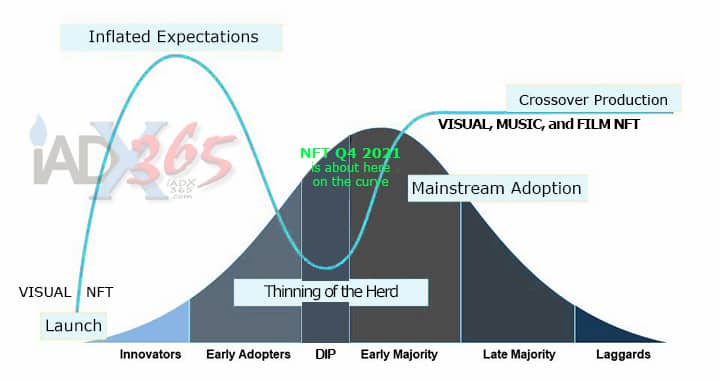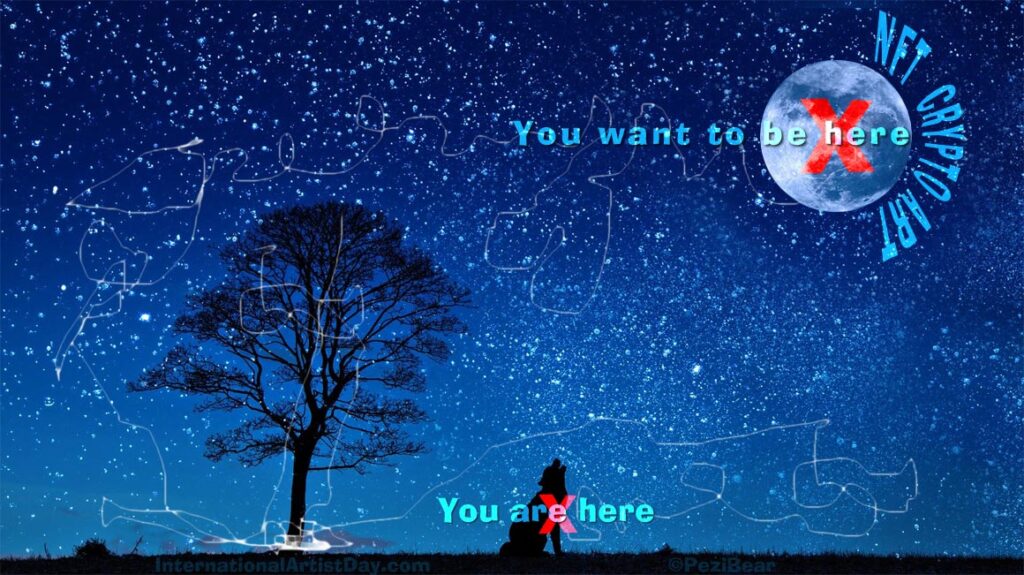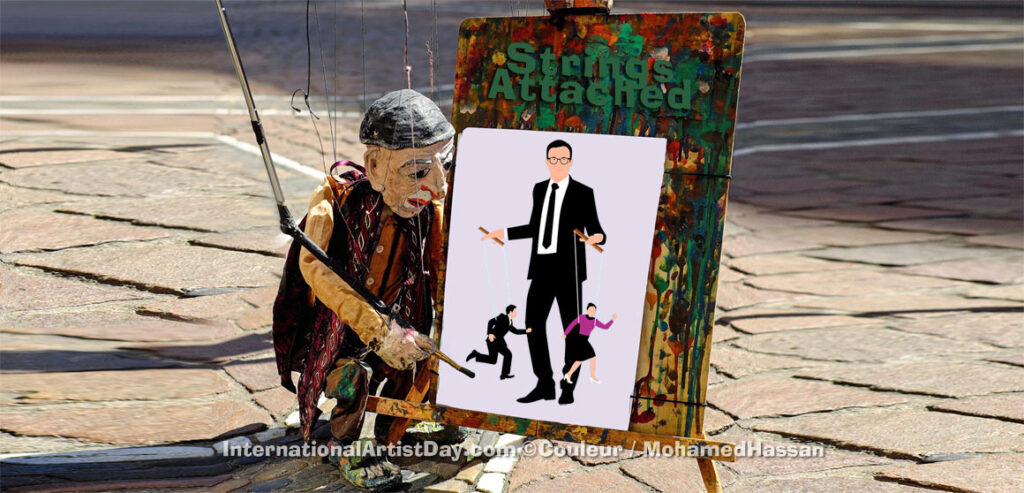– written by Maurice Cardinal
The following article is an opinion piece written by Maurice Cardinal from iADx365. The article was originally posted on iADx365.com. In the article, Maurice explains his thoughts on the current state of NFT technology and how the NFT community and business will develop in the coming months.
Q2/22 NFT is a 360 spin on an icy bridge. We’re still going in the same direction, but slower, and with a tight grip on the wheel. I recently saw an NFT INFLUENCER tweet BUCKLE UP! He wants his followers to believe that NFT is about to moon, again … or something.
BUCKLE UP at this stage is misleading, and the wrong advice.
More accurately it’s DIG IN, because now that the kids have gone to bed it’s time for art pros with experience and money from a career well-managed, to move into the NFT space. And they are, but with well-warranted trepidation after witnessing the recent carnage in NFT paradise.
NFT PHASE III in Q2/22 is exactly what established creatives have been waiting for, and more. Now that the low hanging NFT fruit has been picked, processed, and packed, artists with a more intellectual bent are exploring ways to reclaim the hearts and souls of thinking art collectors.
Being first into a space is only good if you’re the one making the space, but if you’re a follower all it does is suck your energy and money so someone else can prosper. Smart artists chose to bide their time.

The era of big overnight NFT pump and dumps is waning fast for all but the most gullible. Buckle up is not about concern for you as a visual artist or musician. In order to survive, self-professed influencers need engagement juice, and it’s an artist’s time and energy that provides them with free fuel.
If you get railroaded into a PFP rug at this late stage, you deserve it. The warning signs have been here for months. Same thing goes for Discord communities. Get out of that cesspool of conARTISTS, and use YOUR website/blog and Twitter instead. If you’re going to spend all that time building something online, build a platform for yourself and in a way that maintains control for YOU!
DIG IN is great advice for a number of reasons. To begin, NFT isn’t over by a long shot, although you’d never know it if you only listen to all the young artists licking their wounds. Just because they lost their NFT MOJO though, doesn’t mean you will. The upside is that art and music collectors will no longer have to wade through endless reams of Photoshop or Procreate filters of squiggles, or listen to lame ripped off beats ad nauseam.
Hot visual art and music collabs are hitting my timeline on a regular drip.
Almost every day something insanely innovative pops up on my 1/1 feed. Not surprisingly, it’s coming from OG cats who have been around for at least a decade, and who know how to not only create great art, but also how to position and market their work–the GRAIL.
The tips here are primarily for pro fulltime artists and musicians, but if you’ve been stung by NFT, or you’re just starting out and frustrated, the insight here can help anyone. You can adopt and adapt the same strategies and evolve them to grow your emerging art or music career.
The difference in Q2/22 is that the NFT strategy is radically different than just a few months ago. It’s now much less Web3 specific, and instead more like TRANSITIONING to Web3. There is no BIG SWITCH signaling the arrival of all the LIT stuff that Web3 promises to bring.
Art collectors can now see it’s mostly experienced artists successfully carving NFT.
Brilliant young new artists are grinding NFT hard too, but unfortunately many are also still falling for rips and rugs. A few are selling fire pieces, but for the most part young artists are frustrated that they still need part time jobs to pay the bills. I feel your pain, we all do. iADX365 has been helping young and emerging artists since 2004 so we know all the challenges, and what competition between artists means. The reality, unfortunately, is that NFT is harder than it looks, plus, there are more artists than collectors. NFT hasn’t changed anything in this respect–experienced artists never expected it would.
If anything, NFT made competition between artists more difficult, even intense in some cases!
Artists have been groomed by hustlers to falsely believe that artists can do NFT solo. We’ve warned you loudly from DAY 1 – Artists can only do it alone up to a certain point. For starters, it’s why you need a community, specifically your community, which by any definition is NOT alone or easy to manage.
In Q2/22 … NFT, Web3, DAO and the metaverse will all benefit from cross-platform collaboration.
Considering that NFT in principle removes the middle person, it means there is now no one to do all the complex stuff that galleries and music managers and agents do for artists. Tasks like contracts, payouts, licensing, et al. I know it’s cliché, but “ARTISTS can’t have their cake and eat it too!” Someone has to do the heavy lifting, and I know from decades of experience that MOST ARTISTS don’t have the frame of mind–the will or skill to do it. They’d rather create.

Pro artists now watching all the NFT FOMO, figured out years ago how to build credibility and visibility in a traditional contemporary art market. They are not about to walk away from the sweat equity they poured into their careers. They also know that traditional promotion skills are easily transferable. Experienced artists have been waiting patiently for the NFT smoke and dust to settle. I thought it would take a bit longer for NFT to lean into mass appeal–two years or so, not one-and-a-half, but I’m not complaining that common-sense thinking arrived earlier than expected. Several years ago, when I first became involved with CryptoArt I hoped NFT would come out of the gate and launch in the 1/1 mode we see slowly evolving today. Unfortunately, too many grifters using high-pressure sales strategies jumped in to take advantage of a worried and pandemic-stricken body of inexperienced artists.
NFT exploded out of a perfect pandemic storm when everyone was concerned about the future. It meant that out of desperation, too many artists lost sight of reality, erroneously thinking that all they had to do was show up and collect their winnings.
Consequently, we were forced to twist chaotically through mostly low-level NFT art and an infinite stream of artless PFPs only to have confirmed that 1/1 art doesn’t sell the way inexperienced artists were promised it would. We wrote about the manipulations often, and how to spot conARTISTS.
When NFT started to dip in Q1/22, conARTISTS slyly shifted everyone’s gaze toward Web3 and the ethereal METAVERSE, until Zuck bought the name, and then everyone did a WFT about FACE, and naively started to hate on the overall metaverse concept. Zuck’s sister dancing cringe, didn’t help.
The reality though is that SOME styles of NFT really need Web3 and metaverse platforms to work. Today, however, it’s still primarily a thin slice of hybrid art connoisseurs with mostly GAMING and trading interests. This type of NFT is new and exciting, but it’s less about art, and not the only way to roll.
In order to understand how the entertainment dynamic and power shifted, it’s important to look at numbers.
YEARS ago, the gaming industry outdistanced music sales by a wide margin.
The HOT entertainment market today isn’t music, it’s gaming, and it’s where most of the money is funneled.
During this long music-to-gaming transition, music lost its intrinsic value. Today’s numbers reflect that it’s highly doubtful that music will ever regain direct value in the near future, at least to the level it once held. Direct value in music began to fade as the internet and MP3 ramped up. It was a by-product of a number of issues and connected events, including a growing number of musicians with direct access to a dwindling music buying crowd. Also, and this is very important, in general people buy less music as they age. However, they buy more visual art as they develop intellectual sophistication. It’s why cross-platform collaboration is so important. Visual art can now compete directly with music for entertainment dollars. Except for a few players on either side though, not many know it, yet.

Interestingly too, the demographic of the group buying the bulk of music today has changed radically over the last decade. People between thirteen and forty-four purchase sixty-four percent of all music, and people forty-five and up buy only thirty-six percent. Be very careful when looking at music buying stats though because they differ greatly between genres. The demographic changes considerably depending on the type of music. You can’t compare COUNTRY MUSIC numbers to RAP sales respective of NFT. You have to use certified data to first identify what demographic buys your art, and then match your demographic to the type of NFT art and music that is most often sold. It doesn’t work the other way around unless you’re one of the very exceptional artists who change the way the masses think and act, like The Beatles, or more recently, NWA.
The pandemic gutted the music industry because of lockdowns. Bands couldn’t tour to generate revenue from live event tickets and merchandise. The only revenue source became track sales.
Because of their popularity and high volume, only the biggest music acts generate any appreciable revenue directly from track sales. They rely primarily on ticket and merch sales like everyone else. Track sales is a low-margin high-volume game. You need to sell a lot to make a little.
NFT does not fill the void on its own by a long margin. Unfortunately, too many musicians listen to self-professed NFT con experts who claim music now has direct monetary value simply because it’s NFT. It’s a warm and fuzzy dream, but unfortunately, it’s not true, and it’s why musicians have to explore cross-platform collaboration and alternative revenue streams. The reality is that consumers want free music. They will, however, pay massively for supplemental add-ons–what marketing refers to as value added.
NFT is a valuable supplemental ADD ON to all art styles, whether visual or music. It’s unlikely though that NFT will be the primary revenue source for most artists anytime soon–in the future maybe, but not today.
There are exceptions of course, but even then, it’s hard to tell if artists or their confederates are secretly buying their own work to only make it look like they’re LIT. Manipulative artists and art collectors are involved in NFT wash trading and shorting on an increasing basis. Major labels have played this game since time immemorial–well before NFT. Payola and padding accounts are not new concepts. The difference today is that fraud is now easier to spot on a decentralized open ledger.
Another reality is that many NFTs have zero liquidity, which means that you can easily buy an NFT, but you can’t sell it because no one wants it. You’re stuck with a 2E anchor that won’t even secure your boat, let alone help you pay for the gas.
Are there solutions? Of course, but they’re not what most think, and it’s not about an overnight win.
You need luck and hard work just like before, and capital of course to be competitive. Plus, skill, and partners, and a crew and an agent and a manager and all the other talent required to raise credibility and visibility. Fame doesn’t happen by accident, or in a vacuum.
If you’re happy to do Open Mics the rest of your life you can do NFT alone. However, if you have dreams to headline in arenas and at major events, you better start building a team now that can help you manage your NFT community. Context is critical.
Web3 will without doubt become the overarching requisite over the long term.
The metaverse and DAOs will too, but for somewhat different reasons.
You can read more texts and get to know iADx365 by following this link.
Read other stories: DNAverse partners with Polygon Studios to drive the replication of organic life in the Metaverse
SparkWorld* allows its platform to equitably distribute NFTs on launch


